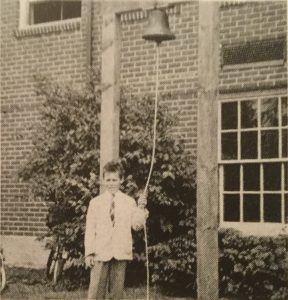During the era of the Lower School, the seventh grade (now the First Form) was called Class D. Befitting the most senior class in the Lower School, its members were the only students permitted to use the main steps to the new building, which opened in February 1946, the first new construction after the war.
 During the 1950-51 school year, Class D under the direction of Mr. Innis, chief of maintenance and grounds, constructed a belfry on which to hang the School’s original bell. As reported in an article by Mr. Densmore: “Reg Howe, son of Richard Howe ‘33 and grandson of the School’s founder, Dr. Howe, rang it for the first time in the new location.” There was an accompanying picture:
During the 1950-51 school year, Class D under the direction of Mr. Innis, chief of maintenance and grounds, constructed a belfry on which to hang the School’s original bell. As reported in an article by Mr. Densmore: “Reg Howe, son of Richard Howe ‘33 and grandson of the School’s founder, Dr. Howe, rang it for the first time in the new location.” There was an accompanying picture:
My memory is that this event took place during the fall of my sixth grade year (1951-52), so it may be that the bell was actually hung during the summer and that the Class D which constructed the belfry was by then in Form II. Unfortunately the original bell has been lost, or at least the capable staff at Alumni House cannot find it. Apparently it disappeared during renovations to the Morse Building following the closure of the Lower School. Originally placed on top of Howe House, it was brought from Cape Cod by my grandfather, probably having been a ship’s bell scoured from a local boatyard.
In my view Ted Densmore, “Mr. D” or “the Mole” as he was often called (depending on the circumstances), is the School’s most unsung hero.
He joined the faculty in 1936 as a French teacher. Upon the death of my uncle Bill Barker in 1938, Mr. D assumed charge of the Lower School and remained its director until its discontinuance in 1961. He also served as director of admissions from 1938 until his retirement in 1974. The Densmore family lived in the house that now serves as the Admissions Building, occupied by the Funks after the Densmores. Their two sons, my classmate and good friend Ned ‘58 and his brother Walter ‘63, are graduates of the School. With them safely launched, Mrs. Densmore served as the School’s librarian from 1970 to 1974.
With the School on the brink of failure in 1941-42, and while many faculty members were either leaving for military service or opting for more stable opportunities, Ted Densmore–along with longtime stalwarts Keller, Jenney and Togneri–stayed on. Fred Hamilton arrived in July 1942 to face a daunting challenge. Only 30 boys were signed up for the coming year with 60 more on the sidelines waiting to see if the School would open. Roger Duncan describes what followed (Duncan, p. 114):
Mr. Densmore, then Director of Admissions, turned to with vigor to find the boys to fill the School. Abandoning the dignified attitude of Plain Jane at the June prom, Mr. Densmore and Mr. Hamilton ceased to wait forlornly for prospects but canvassed, alone and together, among friends, parents, junior schools, public schools, and wherever boys were to be found. The School opened with ninety-six boys in September 1942 and soon added five more for a total of one hundred one.
The School had survived. Through the next two decades the Lower School remained an important draw for the School. Being a relatively young school with a modest endowment, its budget relied primarily on tuition income. Indefatigable, Mr. D seldom missed a chance to promote the Lower School as an excellent entrance to a Belmont Hill education. Asked by Finch Keller to provide some material about the Lower School for the Alumni Bulletin (25th Anniversary Ed., March 1949), Mr. Densmore closed with this soft pitch (p. 44):
Only a handful of alumni really know the Lower School today. The number of students in the three classes has tripled; we have begun to grow into the new building. With our own faculty and better integration, these past four years have seen slow changes towards our objectives. We like to think that a better mouse trap is constantly a-building, that the path to the door is being beaten. It is hoped that more of you will use it in the months to come. A particular invitation goes to those of you who have sons in the primary grades. We’d like to meet them.
